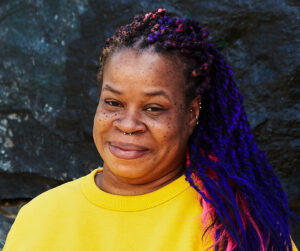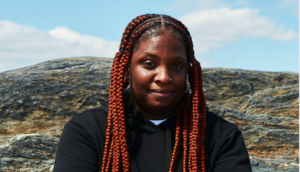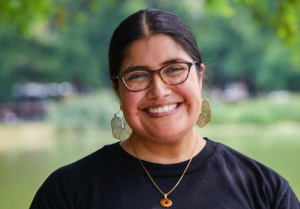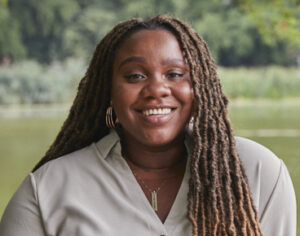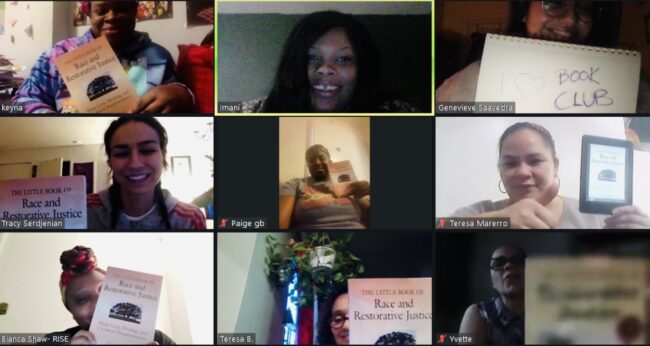
Rise Staff Book Club Kicks Off by Reading The Little Book of Race and Restorative Justice
By Keyna Franklin, Assistant Editor
Keyna Franklin recently launched a staff book club at Rise. Here, she describes why she started the book club, how our learning together can support our work at Rise, and what we are reading.
I started the Rise staff book club because I like reading books and thought it would be good for the Rise team to read some of the books I was reading. The purpose of the book club is to read books that have to do with our work—or to see if and how the topics fit with the work that Rise is doing. Staff at Rise have different perspectives on abolition and systemic reform, and the book club offers a space for coming together as a community, having conversation and sharing our points of view. It is an opportunity to continue to learn from each other.
It feels good to me to run the book club because I wanted to lead facilitation of a group at Rise and have been interested in organizing a book club for a long time. It is important that the book club is run by a parent who is impacted by the system. Parents know what they want and how the system works. It is important to learn about how to navigate the system, the harm the system causes families and communities, the impact of racism, how systems have changed (or stayed the same) throughout the years and how we can make change in our communities.
To pick the first book, I did a poll asking the group what book they would like to read and why. The first book we selected to read together is The Little Book of Race and Restorative Justice by Fania E. Davis. I was excited to see that the team was eager to know more about restorative justice and how it fits into our work. In addition to our circle keeper training, this is another way to learn how to apply restorative justice in our work and our programs with parents. We discussed how we can use restorative justice in our everyday lives with our families and communities, with our children and in our work to heal and support parents.
We learned and talked about how restorative justice is being used in the school system and criminal legal system. The group discussed how restorative justice should be learned in schools, starting with older youth. I believe it is important for schools to have someone who has deep experience with and knowledge of restorative justice who can teach it. I don’t think it’s being used the right way in schools—if it was taught the right way, there would be less harm in the schools.
The book talked about issues that I hear from parents of color at Rise—issues particularly impacting Black and brown communities. Some kids go from school to prison, don’t finish school or aren’t getting the special education support they need. In chapter four on Race, Restorative Justice, and Schools, Fania wrote about harmful systemic factors in schools: “A few of the many such factors include financing disparities for schools in communities of color, tracking and special education placements, the school-to-prison pipeline, and racial disparities in discipline” (p. 57).
Racism does exist, all over the world. The Black and brown community experiences racism, but no matter what people say to you or their assumptions about you, it doesn’t make you any less than who you are. The book urges racial justice advocates to invite more healing into our lives and restorative justice advocates to bring more warrior energies into theirs. There was a quote in the book that tied this idea together for me: “However it looks, let us locate ourselves at the juncture of healing and activism, cultivating and practicing a spacious awareness and praxis of both” (p. 96).
The book also shared different ways to address cycles of harm. Through my work, I’ve been learning about a restorative justice program in Brooklyn. Instead of going to jail, the person who caused harm is supported in talking with the person they harmed, and in repairing the harm. Incarceration affects the family, as well as the person who goes to jail, so the program works with the whole family. The purpose of this process is to stop repeating cycles of harm and incarceration. Healing is hard, but to me, forgiveness is not for those who caused harm—it is for the person who was harmed, so that you can heal and move forward.
Our Next Book: Beyond Survival
The next book that we are going to read is called Beyond Survival by Leah Lakshmi Piepzna-Samarasinha and Ejeris Dixon. The book is about transformative justice, and it explores issues of intimate partner violence, domestic violence and sexual assault. This book can bring up a lot of trauma, but it can also help Rise staff when we are supporting parents who are going through these issues. Many parents come to Rise looking for support around domestic violence with a partner, family member or their children. Many parents write stories for Rise about their experiences with domestic violence, which can help other parents experiencing it to know they are not alone. We plan to publish a series of stories and interviews on the intersection of domestic violence and family policing later this year.
Staff Reflections: The Little Book of Race and Restorative Justice
Facing Systemic Oppression and Building Community
By Shakira Paige, Peer Trainer
I chose to be part of the book club to learn and read different books with a group—to hear different aspects of the book that stood out to other Rise staff and their take on the issues we’re discussing. I’m excited to learn and interested in how what we’re learning about will support our work. By learning about our major issues as a community, we can support each other and become one to fight for what we believe is right.
The Little Book of Race and Restorative Justice highlighted racial disparities in school discipline. In our book club’s discussion about it, we all felt the same way—that teachers are so negative toward Black students and kids don’t have a voice in their schools about issues that affect them. The teachers and staff pick and choose their responses. When it’s my kid and somebody else’s kid of a different race, the other child walks away clean while my kid gets suspended.
For my son’s situation at his school, and for families involved with the family policing system—they are all still in the world of systemic oppression. These systems judge the Black and brown community with racism. People working in these systems look down on us because we live in poverty, and just because they make better earnings they don’t think people should struggle.
To me, reading this book showed what our peer support work will be like—for communities to disrupt the mass destruction of the family policing system. We want to cause less harm and make it so families asking for support do not have to fear getting involved with ACS or the police.
No matter what we go through in life, until we decide to stop committing violence against each other, it will keep happening. We need to change the narrative of how the community looks upon each other, stop all the violence so we live in a safe environment, put the guns away and help one another. We need to build a better community with trust, ambition, empathy, care and love.
Exploring the Possibilities and Limitations of Restorative Justice Approaches
By Genevieve Saavedra Dalton Parker, Development Director
It was an obvious and enthusiastic “Yes!” for me when we were invited to take part in a book club that is focused on deepening our learning of restorative, transformative and healing justice, through the lens of Black feminism and towards abolition. What a gift. Learning spaces can be sacred spaces. I’ve witnessed a lot of vulnerability, wisdom and courage when people share feelings, thoughts and interpretations of liberation books. I definitely wanted to be part of a space where people intentionally bring real-life experiences and imaginations of what’s possible into the same room. There’s so much to learn from each other.
A big question that we see in communities of people traumatized by systems that have existed for longer than our entire lives is, “How can this actually change?” By referencing people who have long practiced liberation work and also examining our own knowledge and ways of being in relationship to our loved ones, families of origin, chosen families and so on, we can see how we are connected to lineages of revolutionaries, people trying to make the world a more humane and compassionate place to exist. From the big cultural picture to the smaller, more intimate personal, even internal, picture—this is the kind of space that education for liberation can create.
Some exciting themes that emerged from the book were how vital healing practices are to racial justice and vice versa. Fania speaks to the importance of being in balance with the “healer” and the “warrior” spirits. How can we tap into our own healing and compassion while firmly defending ourselves against injustice and violence? How do we protect ourselves from falling into the traps of white-supremacist-imperialist-cis-hetero-patriarchal-capitalist culture that bell hooks’ teachings guide us to identify? And if/when we do, how can we re-center, re-ground and restore ourselves? How can we extend this level of grace and compassion to each other? What does it look like to support each other to undo the conditioning and internalized impacts of anti-Blackness? Fania shows us how racial justice is imperative to restorative justice (RJ), and how restorative justice is a practice that can help us sit with the messiness and use a different set of approaches than punishment.
And yet, RJ is a practice and not the entire solution. We’ve talked about the ways that RJ has been co-opted and exploited by the very systems that rely on punishment and continue cycles of violence, never reaching the root conditions of the issues at hand. Many parents named and agreed that schools have tried to implement restorative justice practices but failed to recognize the implicit racial bias held by school staff. We know that RJ is also used in the criminal legal system. Some questions we sat with were, “Who benefits from this? If it improves the criminal legal system, is that making the system stronger? What would it look like to give communities the resources to more sustainably hold RJ circles and other non-punitive practices for their community?”
We also talked about the possibilities and limitations of “reconciliation” as an adequate restorative response to systemic harm, in the case of separating Indigenous children from their families to be forced into boarding schools. We talked about the stark differences between performative reconciliation and material reparations. For many directly impacted people, while there’s a need for acknowledgment of the harm done, the acknowledgment can also be incredibly painful. Ongoing healing and tangible support are necessary and often lacking in state reconciliation efforts.
Embracing Warrior and Healer Spirits
By Bianca Shaw, Rise Co-Executive Director
One of my favorite things about Rise is that we don’t just “talk the talk” about what we want our world to look like, but we take the time to do the internal work of learning about, and grappling with, different ways of thinking and being. The book club is a reflection of that. It’s been a great place for everyone to learn together. I especially love that no one is an expert—we’re all just curious together, giving each other space to reflect and even engaging in healthy debate.
There were so many good parts of the book. Fania spoke about dismissing the binary of warrior and healer and that really spoke to me. Healing, although important, is not enough. She reminds us that we must take action, have a strategy and continue to hold systems accountable. Fania notes, however, that a “warrior spirit” is also not enough. In order to dismantle systems of oppression, we must heal from the ways that we have been harmed by them and we must do everything we can to strip them of their power.

